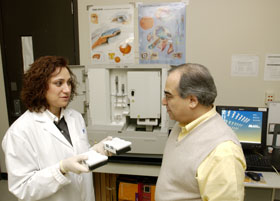News Release
April 20, 2005
Contact: Patrick Keefe, 860-679-2447
e-mail:
keefe@nso.uchc.edu
Health Center Research Team Discovers New Glaucoma Gene

Researchers Mansoor Sarfarazi, right, and Dr. Sharareh Monemi discuss samples in their lab at the Health Center. The two have discovered a gene that is expected to help in the diagnosis and treatment of glaucoma.
Photo by Peter Morenus
FARMINGTON, Conn. – Researchers at the University of Connecticut Health Center have discovered a gene that causes late-onset primary open-angle glaucoma.
The discovery was made by Mansoor Sarfarazi, Ph.D., director, Molecular Ophthalmic Genetics Laboratory and professor of human molecular genetics, Surgical Research Center, Department of Surgery, and his graduate assistant and doctoral candidate Sharareh Monemi, M.D.
The gene is the third glaucoma-causing gene discovered by the Molecular Ophthalmic Genetics Laboratory. The newly identified gene is WDR36 and maps to the GLC1G locus on chromosome 5q22.1.
The discovery will enhance screening for the late-onset form of glaucoma. It will improve early diagnosis of glaucoma, which allows earlier and better treatment, and the discovery also advances the likelihood of gene-targeted therapies.
“Finding this gene was gratifying,” Sarfarazi said. “This discovery
will improve screening of at-high-risk individuals and help to identify
those who could develop glaucoma decades later. It will also help in
designing more effective treatments for them.
“But the real work has just begun,” he said. “There’s always more to learn.”
Peter J. Deckers, M.D., dean of the School of Medicine and executive vice president, said Sarfarazi’s discovery was the latest example of the high quality scientific research now being conducted at the Health Center.
“This laboratory continues to work at the cutting edge of gene definition as causative factors in serious ocular problems,” he said, “and as a result of their seminal research contributions have established for themselves, and the Health Center, an international reputation in the new biology of this decade – specifically molecular diagnosis, and in time, molecular treatment.”
Glaucoma affects more than 2 million Americans and more than 33 million people worldwide. After cataracts, it is the second largest cause of blindness. Although there is no cure, medication or surgery can be effective treatments.
The numbers involved in the discovery were daunting: the researchers were originally faced with a universe of three billion base pairs of DNA material. That number was winnowed to 35 million pairs by locating the region of the chromosome where the gene was thought to reside. Additional study further narrowed the number to 7 million and colleagues working on a similar problem in Oregon helped narrow it further to 2 million base pairs of DNA.
In the end, Sarfarazi and Monemi investigated over 34,000 base pairs of DNA before the one mutation they were searching for turned up.
“This was like hunting,” Sarfarazi said. “Of the original 35 million base pairs, only one change eventually proven to be significant. But this was like searching for the proverbial needle in a haystack.”
The WDR36 gene is conserved - nearly the same - along the evolutionary path from the mouse to rat, dog, chimp and human, Sarfarazi said. Essential genes, vital to an important biological function such as vision, change less through evolution than other non-essential genes, he said.
Monemi was thrilled with the work.
“With my background as a physician, I understand the importance of helping patients,” she said. “Not having your vision from birth is one thing, but losing it to glaucoma decades later would be terrible. This work can help make that loss less common.”
The research should help Monemi’s career too: it’s the subject of her doctoral thesis.
Sarfarazi’s Molecular Ophthalmic Genetics Laboratory also discovered another gene known as Optineurin that causes adult-onset primary open angle glaucoma in 2002. In 1997, he further identified and published information on the CYP1B1 gene that causes primary congenital glaucoma.
The current work was published in the March issue of the journal Human Molecular Genetics.
UConn Health includes the schools of medicine and dental medicine, the UConn Medical Group, University Dentists, and John Dempsey Hospital. Home to Bioscience Connecticut, UConn Health pursues a mission of providing outstanding health care education in an environment of exemplary patient care, research and public service. More information about UConn Health is available at www.uchc.edu.
Note: News professionals are invited to visit the UConn Health Today news page (http://today.uchc.edu) for regularly updated news and feature stories, photos and media stories. News releases are archived at http://today.uchc.edu/newsreleases/2014. UConn Health news and information is also available on Facebook, Twitter and YouTube.

